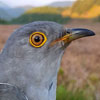 |
| My Bullfinch family Photo: John M Elliott. |
A pair of Bullfinches lived in my garden over the summer, regularly eating at my bird table, They disappeared for a few weeks, and have now returned, with one extra male. Checking the latest lists of Birds of Conservation Concern, I see that they are Amber listed, so great to feel that I am doing something valuable in feeding them. Somewhat alarming though in going through the Red and Amber lists is that half the birds that visit me are on either the Red or the Amber list.
Red listed are House Sparrow, Greenfinch and Starling, all constantly present, plus Herring Gull which has been recorded. Looking back 80 or more years I can’t help thinking of the farmyards of my youth which rang all day with the chirrups of 30 or 40 House Sparrows, then still regarded as a pest species.
Amber listed are Wood Pigeon, Rook, Wren, Dunnock, Bullfinch and Song Thrush, all once very common birds. Moor Hen and Grey Wagtail have occurred and on one never to be forgotten occasion a Nightjar sat on the ridge of my old cedar greenhouse for a whole day.
























